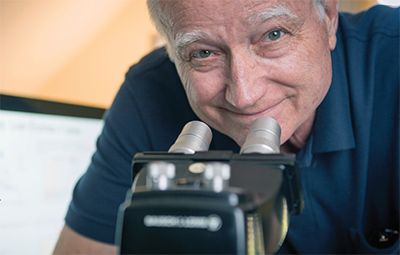A straight line might be the shortest route between two points, but it’s not always the most desirable course. For J. Carl Craft, M.D. ’72, a more direct path might have led him far afield from his ultimate career, and the world of pharmaceutical research would have been far poorer as a result.
In high school, Craft was groomed for Stanford University’s nuclear physics program; the father of a close childhood friend was a researcher building the university’s linear accelerator, and together, Craft and his friend were regular visitors to campus, eagerly exploring the accelerator and the computer equipment. As high school graduation approached, however, Craft determined that nuclear physics was not his path.

His next twist came during medical school. Initially, Craft considered studying psychiatry, but soon decided you “had to be crazy to do psychiatry,” though, he adds, “being a nuclear physicist was even crazier.” By the time he left for George Washington University’s (GW) Foggy Bottom campus, he had his sights set on pediatrics — but his path had one more kink in store.
The summer before his third year of medical school, Craft took a summer job with Hazleton Laboratories in Virginia, working on a project gathering data on Cromolyn sodium, an asthma medication. “I collected and evaluated the data, then wrote the package insert [the description and classification, regulatory specifications, and drug interaction materials] for the drug,” he says. The total new drug application filing was six copies of 92 volumes.
That experience foreshadowed Craft’s future in pharmaceuticals, but years would pass before he found himself working in the industry.
Craft graduated from GW a married man in 1972, and he and his wife, Susan, moved to Wisconsin for his pediatrics residency at Milwaukee Children’s Hospital. It was the Vietnam Era when he completed residency, he recalls, and those who guaranteed two years of military service could select the branch they would join. Craft joined the Navy. “That allowed me to finish my training,” he explains. “I entered as a pediatrician [serving in Guam as lieutenant commander and chief of pediatrics at the U.S. Naval Regional Medical Center], which was lucky since the war ended and 100,000 women and children were temporarily housed on Guam before being moved to the mainland.”
Following military service, Craft started a pediatric infectious disease fellowship at the University of Texas Southwestern in Dallas under the guidance of George McCracken, M.D., and John Nelson, M.D., founders of The Pediatric Infectious Diseases Journal. He later joinedthe faculty at Tulane University in New Orleans, where he treated patients with infectious diseases, taught students, residents, and fellows, and was an investigator in clinical trials for pediatric antimicrobial drugs.
Despite his steady progression in medicine, Craft felt himself drawn to clinical drug research — specifically to Abbott Laboratories, where he developed the antibiotic clarithromycin, the first billion-dollar drug. When the pharmaceutical giant decided to move out of anti-infective drug development, however, Craft retired, but kept an eye open for the next turn of his career path.
That turn came up quickly in the form of Medicine for Malaria Venture (MMV), a new, nonprofit foundation funded by The Bill and Melinda Gates Foundation (BMGF) and others, designed to work on malaria drugs. At MMV, Craft, who served as chief scientific officer, developed the largest anti-malaria drug portfolio to date. MMV has continued to work to eliminate malaria with new medications, created with the stipulation that they cost no more than $1 per treatment.
Both during and after his tenure at MMV, Craft served as a scientific adviser to Drugs for Neglected Disease Initiative in Geneva, a nonprofit drug research and development organization that works on new treatments for neglected diseases, such as leishmaniasis, Chagas disease, and parasitic infections. He also served as a scientific adviser to an ANACOR Pharmaceutical and BMGF project to develop new drugs for tuberculosis and macrofilarial diseases. Rounding out his role as a scientific adviser, Craft, who maintained the role of chief medical officer as well, helped start a new drug company, CEMPRA Pharmaceutical, which is developing two anti-infective agents for serious infections.
More recently, Craft launched Aquarius Biotechnologies Inc. The company, he says, has developed new delivery technology for large-molecule drugs that cannot be absorbed from the gastrointestinal (GI) tract. When given intravenously amphotericin B can decrease nephrotoxicity. Only through nanotechnology, or cochleates, can molecules like amphotericin B be taken orally. The cochleates, he explains, are absorbed across the GI tract, actively taken up by macrophages within the blood stream, and delivered to the site of infection through the patient’s lymphatics. As a result, high levels of the drug do not appear in the blood stream, which could decrease kidney damage.
This unique drug delivery technology, he adds, can formulate and stabilize a variety of molecules, including pharmaceutical drugs; insulin and vaccines; peptides; DNA plasmids, or gene therapy; and siRNAs.
Craft’s career may have drawn him away from his high school plan of studying nuclear science, but the path he followed led to an illustrious career of discoveries in an innovative medical field.



